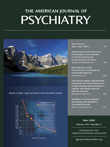Ten-Year Prospective Follow-Up Study of the Naturalistic Course of Dysthymic Disorder and Double Depression
Abstract
Objective: The purpose of this study was to describe the 10-year course and outcome of dysthymic disorder. Method: The authors conducted a naturalistic, prospective, longitudinal follow-up of 97 adults with early-onset dysthymic disorder and 45 adults with nonchronic major depressive disorder selected from consecutive admissions to several outpatient facilities. Follow-up data were obtained for 90% of the cohort. Assessments were conducted at baseline, 30, 60, 90, and 120 months. Measures included the Longitudinal Interval Follow-Up Evaluation and the Hamilton Depression Rating Scale. Results: The Kaplan-Meier estimated recovery rate from dysthymic disorder was 73.9%, with a median time to recovery of 52 months. Among patients who recovered, the estimated risk of relapse into another period of chronic depression was 71.4%. Chronic depressive relapses took a variety of forms and were not limited to dysthymia. Nonetheless, the distinction between chronic and nonchronic forms of depression was relatively stable over the follow-up period. Mixed-effects models indicated that patients with dysthymic disorder experienced a significantly slower rate of improvement in symptoms over time and exhibited significantly greater depression at the 10-year point, compared to patients with nonchronic major depression. Conclusions: Dysthymic disorder has a protracted course and is associated with a high risk of relapse. The nature of chronic depressive episodes varies over time within individuals, indicating that the various manifestations of chronic depression in DSM-IV do not represent distinct disorders. However, the distinction between chronic and nonchronic forms of depression is relatively stable and may provide a useful basis for subtyping in genetic and neurobiological research.



